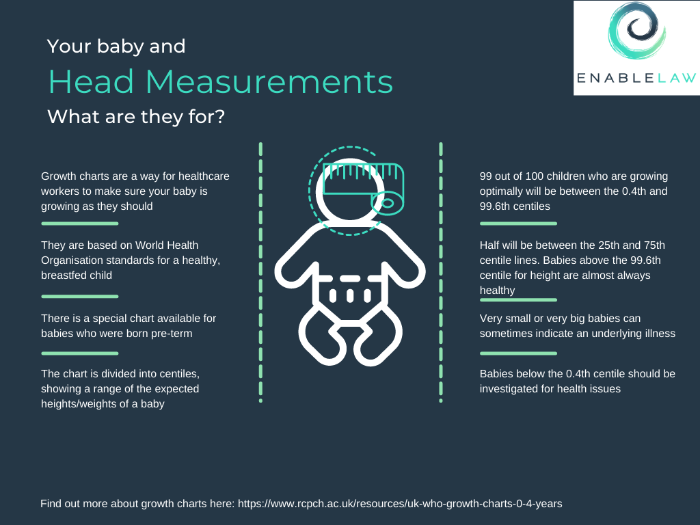
When you have a baby, his or her growth will be measured by the health visitor or doctor at regular intervals. The measurements will be plotted on ‘baby growth charts’ to make sure that your child is on track.
The growth and weight charts are known as ‘centile charts’ and are recorded in your baby’s Personal Child Health Record (Red Book) Measurements. They include weight, length and head circumference.
The World Health Organisation (WHO) provides the standard 0-4 years growth charts. If baby’s head is larger than average, it can be a sign that they have hydrocephalus or are developing hydrocephalus.
So, when should you be concerned about your baby’s head size, and how does head size relate to a hydrocephalus diagnosis? Here, we’ll explore these questions – plus how to pursue a medical negligence claim if your practitioner missed the signs.
Should I be concerned about my baby’s head size?
The average newborn baby has a head that measures about 34.2cm.
Head sizes vary from baby to baby, so a head that’s a little large or small is not always something you should be concerned about. But it’s worth looking out for larger than average head sizes.
An unusually large head – known as macrocephaly – is one of the symptoms of hydrocephalus, for instance. Microcephaly is a smaller head than is typical and can be associated with other conditions.
If you are concerned about your baby’s head size, either during pregnancy or after birth, you might choose to discuss this with a health professional.
If your baby’s head is measuring much bigger than his or her body during pregnancy, your antenatal team might flag this – usually at an ultrasound scan in your second or third trimester. At this stage, they likely won’t know the cause.
Your baby should also have their head measured at a check-up when they are between six and eight weeks old – this is standard across the UK. At this appointment, your GP or health visitor should be able to pick up anything that doesn’t look quite right.
HOW BABY HEAD MEASUREMENTS ARE TAKEN
To measure your baby’s head, the health visitor or doctor will wrap a tape measure around the widest part of your baby’s head from above their eyebrows, above their ears, to the back of their head.
The measurements are plotted on a chart – the centiles (lines) on the chart show the expected range of weights and heights/lengths. Each centile describes the number of children expected to be below that line, for example 50% below 50th centile.
To find your baby’s centile for their head circumference, you would draw a straight line on the chart lengthways from your baby’s head circumference and another downwards from his or her age. If these two lines meet at a centile, it means that your baby is in that centile for head circumference.
Where normal growth and development occurs and your baby is growing optimally, the measurements will be between the two outer lines.
WHEN SHOULD MY BABY’S HEAD CIRCUMFERENCE BE MEASURED?
The WHO guidance advises that “head circumference should be measured around birth, at the 6-8 week check up and at any time after that if there are any worries about the child’s head growth or development”.
CAN THE MEASUREMENTS INDICATE A PROBLEM?
If your baby’s head circumference is measuring too small or big, it can be a sign of an underlying health condition. Your baby’s length or height should be measured whenever there are any worries about weight gain, growth or general health.
Head circumference centiles usually track within a range of one centile space. After the first few weeks, a drop or rise through two or more centile spaces is unusual. This happens in less than 1% of infants, so doctors and your health team should carefully investigate it.
WHAT DOES IT MEAN IF MY BABY’S HEAD IS MEASURING LARGE?
If your baby’s head has grown more than expected, this is called macrocephaly. Although it is not always something to worry about, a large head can be associated with certain health conditions, such as hydrocephalus.
A head circumference above the 99.6th centile or crossing upwards through two centile spaces (for example from the 25th centile line, past the 75th) can be a cause for concern, especially if there is a continued rise or any other signs or symptoms are present.
If this happens, your baby should be referred for further investigations, which could include imaging such as a CT scan or MRI.
Investigations may reveal an underlying health condition which is responsible for abnormal head growth and requires prompt treatment. One example is hydrocephalus; a condition causing excessive fluid in or around the brain. It is caused by either:
- A lack of absorption,
- A blockage of flow, or
- Overproduction of the cerebral spinal fluid (CSF) that is made inside the ventricles.
The ventricles are the fluid-filled areas of the brain. The CSF disperses from the ventricles around the brain and spinal cord. A problem with the system can result in a build-up of the CSF that can cause the pressure inside the head to rise and the head circumference to increase.
In babies, hydrocephalus can cause the bones of their skulls to separate and expand to larger than normal. This will be visible either by looking at the baby, or by measuring their head circumference.
If hydrocephalus occurs, it can affect your baby’s brain and development. Early recognition, proper treatment and infection prevention are all crucial. With a timely diagnosis, it is sometimes possible to:
- Remove the obstruction
- Drain excess fluid
- Using a ‘shunt’ device to keep cerebrospinal fluid away from the brain
- Operate to create a new pathway for fluid
WHY IS RECORDING HEAD CIRCUMFERENCE IMPORTANT?
Regular growth recordings enable your health visitor or GP to record your baby’s measurements as they grow to identify how they are growing in comparison to the average growth curve on the chart.
A difference in growth pattern can indicate a problem, such as hydrocephalus. Your baby’s health visitor or GP should investigate any measurements that fall outside the ‘normal’ range.
Your GP and health visitor have a legal duty of care towards their patients and as such, any failures in care that result in missed or delayed diagnoses or treatments can give rise to a legal claim.
An example of a failure in your baby’s care could include:
- Not appreciating a disproportionate head size, which if noted, would have led to head circumference remeasurements and/or referrals for further investigations
- Failing to conduct the proper follow-ups.
In one 2020 hydrocephalus negligence case in Leicestershire, we found health visitors had failed to measure a baby’s head, though they had taken down his weight. Teams also failed to refer the child for assessment and did not monitor the pattern of growth in the standard way.
ARE YOU CONSIDERING WHETHER YOU NEED LEGAL SUPPORT?
We hope the information above gives you a more solid understanding of what to look out for if you or your clinician is concerned about hydrocephalus.
If you have any worries and concerns about whether your child has an injury because something went wrong in the care either you or they received, investigating whether there is a negligence claim can help to find answers.
This is a detailed process that, if successful, can provide your child with additional resources to ensure their care, aids and equipment and therapy needs are met for life and a suitably adapted property purchased for them to live in with you.
Katherine Pearce, a medical negligence lawyer with Enable Law, has helped families affected by hydrocephalus negligence to:
- Make their home more suitable
- Appoint someone to coordinate care
- Pay for therapy and rehabilitation.
Our team at Enable Law will work with you to determine what happened and whether the care provided was substandard. Contact us to begin your journey.
If it was, we can help work out what specific care, therapy and equipment needs your child is likely to have to make it possible for them to achieve their maximum potential.
There’s support every step of the way, whether your claim is for general medical negligence or a specific issue related to hydrocephalus, such as brain injury negligence.
Hydrocephalus: Key questions.
What is considered a big head for a baby?
A big head is considered to be one with a circumference above the 99.6th centile for your baby’s age and sex. There are other factors at play, however, such as parental head sizes, and if a baby is born pre-term. Speaking to a doctor is often the best way to understand what your baby’s head size means for them.
How accurate are ultrasound head measurements?
Ultrasound scans can sometimes be inaccurate – these may be more likely to underestimate your baby’s head size compared to post-birth measurements. For this reason, some health professionals prefer to exercise caution if a baby’s head measurements look a little off during pregnancy.
How does hydrocephalus affect a person?
Hydrocephalus can affect:
- Head size
- Sleep quality
- Vision
- Balance
- Concentration
- Appetite
- Cognition and memory
Symptoms can vary significantly and may differ based on when the condition was diagnosed.










